Figure Counting: Meaning, Reasoning Questions with Answers, Formula
Imagine a square containing a small triangle inside it. How many shapes can you count in this simple figure? At first glance, it seems like just two, but if you consider overlapping areas and hidden segments, the total can increase. This process of carefully identifying and counting all individual shapes, including triangles, squares, circles, and other geometric patterns, is known as figure counting. Figure counting is a crucial part of reasoning sections in competitive exams such as CAT, SSC, RRB, IBPS, and various bank and government tests, where sharp observation and analytical skills are tested under time pressure.
This Story also Contains
- What is Figure Counting? - Definition and Basic Explanation
- Approach to Solve the Questions Based on Figure Counting Reasoning
- Types of Questions Asked from the Figure Counting Reasoning
- Non-Verbal Reasoning Topics
- Recommended Books and Online Resources for Figure Counting
- Figure Counting Tricks to Solve the Counting of Figure Reasoning Questions
- Practice Questions For Counting the Squares
- Practice Questions For Counting the Rectangles
- Practice Questions For Counting the Triangles
- Practice Questions For Counting the Quadrilaterals
- Figure Counting Questions PDF Download
- Figure Counting Questions for BITSAT/ CUET
- Figure Counting Questions for SSC CGL/ SSC CHSL/ SSC CPO/ SSC Stenographer exams
- Figure Counting Questions for Railway Recruitment Board - RRB Exams
- Previous Year Questions of Figure Counting in Various Exams
- Preparation Tips for Figure Counting
- Verbal Reasoning Topics

What is Figure Counting? - Definition and Basic Explanation
Figure counting is a fundamental reasoning skill that involves identifying and counting all the shapes, figures, and geometric patterns present in a given diagram. These diagrams can include simple shapes like triangles, squares, and circles, or complex, overlapping, and nested figures. The primary goal is to accurately determine the total number of individual elements, considering hidden and intersecting parts. By practicing figure counting, candidates can improve their ability to quickly analyze patterns, recognize hidden elements, and apply logical formulas for accurate answers.
Approach to Solve the Questions Based on Figure Counting Reasoning
To solve questions related to figure counting, reasoning, follow the steps below:
1) The first step is to identify which figure has to count, such as a triangle, a rectangle, a square, a quadrilateral, etc.
2) Let’s assume that a counting figure question asks to find the number of triangles in the given figure. For this, we have to label the figure and then point out the different vertices that make the complete triangles together.
3) The third step is to start counting the figures from the bigger ones.
4) After labelling, we will be able to identify the different triangles and track the number of triangles in the figure. The same needs to be followed for other shapes as well.
Types of Questions Asked from the Figure Counting Reasoning
The topic of figure counting reasoning is divided into various parts based on the counting of different shapes, and they are as follows -
Count the total number of Squares
Count the total number of rectangles
Count the total number of triangles
Count the total number of quadrilaterals
Let’s discuss these types and figure counting formulas in detail with the help of examples -
1. Count the Total Number of Squares
In this type, we have to count the total number of squares in the given adjoining figure. For this, label the given adjoining figure, and point out the different vertices that together make the complete square. By using these vertices, we can count the number of squares in the given figure. Let’s understand this with the help of an example.
Example: Consider the diagram given below and count the number of squares.

To count the number of squares in the above adjoining figure, first, we have to label the figure and then count the number of squares. The given figure can be labelled as shown below:
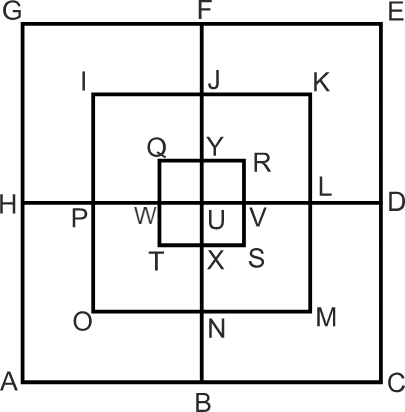
The squares in the above figure are - QYUW, WUXT, YRVU, UVSX, QRST, IJUP, PUNO, ULMN, JKLU, IKMO, GFUH, HUBA, UDCB, FEDU, and GECA. Thus, there are a total of 15 squares in the above figure.
2. Count the Total Number of Rectangles
In this type, we have to count the total number of rectangles in the given adjoining figure. For this, label the given adjoining figure, and point out the different vertices that together make the complete rectangle. By using these vertices, we can count the number of rectangles in the given figure. However, while counting the number of rectangles, we have to consider the squares as well. All squares can be rectangles but all rectangles cannot be squares. Therefore, in the counting of rectangles, we have to count the number of squares in the given figure. Let’s understand this with the help of an example.
Example: Consider the diagram given below and count the number of rectangles.
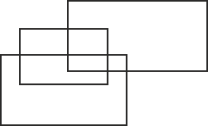
To count the number of rectangles in the above adjoining figure, first, we have to label the figure and then count the number of rectangles. The given figure can be labelled as shown below:
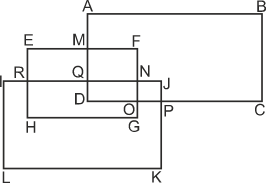
The rectangles in the above figure are - ABCD, EFGH, IJKL, MFNQ, EMQR, EFNR, QNOD, NJPO, QJPD, RNGH, MFOD. Thus, there are a total of 11 rectangles in the above figure.
3. Count the Total Number of Triangles
In this type, we have to count the total number of triangles in the given adjoining figure. For this, label the given adjoining figure, and point out the different vertices that together make the complete triangle. By using these vertices, we can count the number of triangles in the given figure. Let’s understand this with the help of an example.
Example: Consider the diagram given below and count the number of triangles.
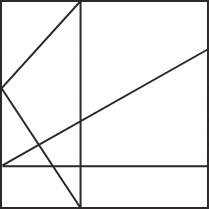
To count the number of triangles in the above adjoining figure, first, we have to label the figure and then count the number of triangles. The given figure can be labelled as shown below:
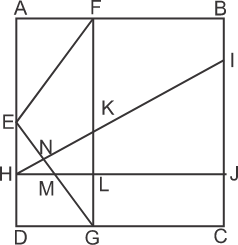
The triangles in the above figure are - AFE, EDG, EFG, EHN, HNM, EHM, HIJ, GML, GNK, and HKL. Thus, there are a total of 10 triangles in the above figure.
4. Count the Total Number of Quadrilaterals
In this type, we have to count the total number of Quadrilaterals in the given adjoining figure. For this, label the given adjoining figure, and point out the different vertices that together make the complete quadrilaterals. By using these vertices, we can count the number of quadrilaterals in the given figure. However, while counting the number of quadrilaterals, we have to consider the squares and rectangles as well. All the four-sided enclosed figures are quadrilaterals, irrespective of the shape. Let’s understand this with the help of an example.
Example: Consider the diagram given below and count the number of quadrilaterals.
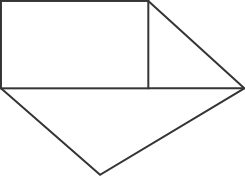
To count the number of quadrilaterals in the above adjoining figure, first, we have to label the figure and then count the number of quadrilaterals. The given figure can be labelled as shown below:
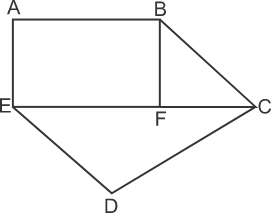
The quadrilaterals in the above figure are - ABFE and ABCE. Thus, there are a total of 2 quadrilaterals in the above figure.
Non-Verbal Reasoning Topics
Non-verbal reasoning topics assess your ability to analyze and interpret visual information without using words or numbers. These include non-verbal analogy reasoning, figure series reasoning, classification, embedded figures, cube and dice reasoning, mirror and water images, and completion of figures, all of which enhance pattern recognition and problem-solving skills. The important non-verbal reasoning topics are given below:
Recommended Books and Online Resources for Figure Counting
Recommended books and online resources for figure counting provide the right mix of theory, solved examples, and practice questions to strengthen your skills. These resources help aspirants master counting of figures reasoning questions with speed and accuracy.
Book Title | Author |
A Modern Approach to Verbal & Non-Verbal Reasoning | R.S. Aggarwal |
SSC Reasoning Chapterwise and Typewise Solved Papers | Kiran Prakashan |
A new approach to Reasoning | B.S. Sijwali & Indu Sijwali |
Objective Reasoning for Competitive Examinations | Arihant Experts |
Question Weightage of Figure Counting Reasoning in Competitive Exams
The number of counting of figures reasoning questions asked in competitive exams can vary depending on the exam type and difficulty level. These questions are generally quick to attempt if practiced well, making them a scoring topic for candidates.
SSC Exams (SSC MTS, SSC CGL, SSC CHSL, SSC CPO, Stenographer): Usually 2 to 3 questions are asked, often involving triangle counting or mixed shape diagrams.
RRB Exams (Group D, NTPC, JE, ALP, etc.): Around 2 to 3 questions are common, typically based on basic counting figures reasoning with moderate complexity.
Banking Exams (Bank PO, Bank Clerk): Generally 1 to 2 questions are asked, often straightforward but requiring accuracy under time pressure.
Figure Counting Tricks to Solve the Counting of Figure Reasoning Questions
This section covers proven tricks and shortcuts to quickly and accurately solve figure counting reasoning questions, helping you save time and avoid common mistakes in competitive exams.
1. Count the Number of Squares and Rectangles
To count the number of squares and rectangles in a figure, firstly, we have to number the divided parts in the figure as shown below.
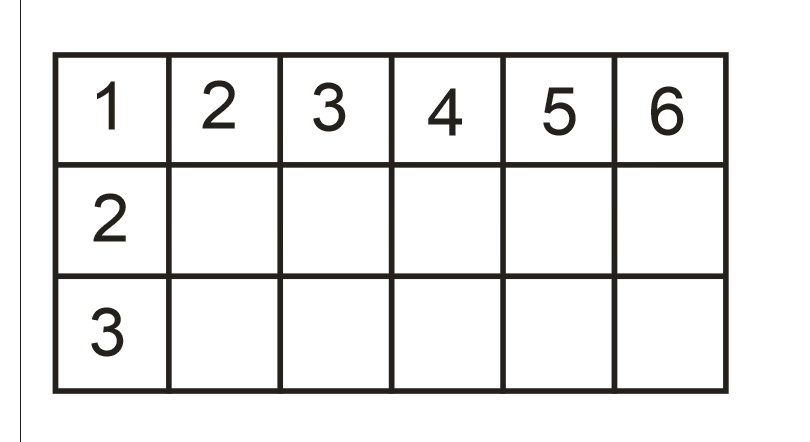
To determine the number of squares, multiply the last number in the row by the last number in the column and then multiply the numbers after subtracting 1 from both numbers. Continue the procedure until one of the two numbers becomes 1, and then add all the resultant numbers to get the number of squares.
Number of squares $= (6 \times 3) + (5 \times 2) + (4 \times 1) = 18 + 10 + 4 = 32$
In the above figure, there are a total of 32 squares.
To determine the number of rectangles, multiply the sum of the numbers in the first row and the sum of the numbers in the first column.
Number of total rectangles $= (1 + 2 + 3 + 4 + 5 + 6) \times (1 + 2 + 3) = 21 \times 6 = 126$
In the above figure, there are a total of 126 rectangles. (These rectangles also include the count of squares, because all squares are rectangles, but all rectangles are not squares.)
There is one more figure-counting trick to calculate the number of squares and rectangles in a square (when the number of rows is equal to the number of columns):
The number of squares $= \frac{n(n + 1)(2n + 1)}{6}$
The number of rectangles $= \left(\frac{n(n + 1)}{2}\right)^2$

Here, $n = 6$
So, the total number of squares $= \frac{6 \times 7 \times 13}{6} = \frac{546}{6} = 91$
The total number of rectangles $= \left(\frac{6 \times 7}{2}\right)^2 = \left(\frac{42}{2}\right)^2 = 21^2 = 441$ (Squares are also included)
NOTE: But, in case, if the question asks “only rectangles” instead of “total rectangles”, then subtract the number of squares from the total number of rectangles.
2. Count the Number of Triangles
Let’s consider some figures of the triangle of a common type.
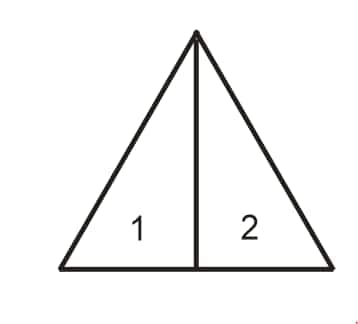
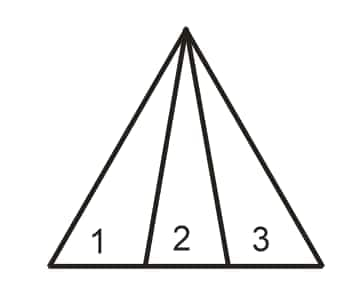
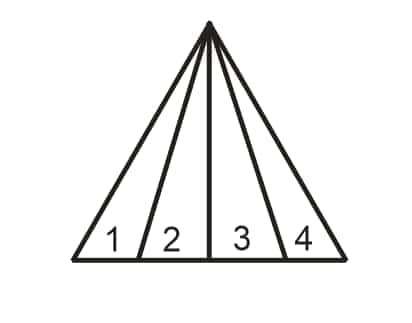
In these types of triangles, we will count the total number of triangles on the basis of the number of bases in each triangle. In the first figure, we have 2 bases, in the second figure, we have 3 bases, and in the third figure, we have 4 bases. Let us consider that ‘n’ denotes the number of bases.
So, the total number of triangles $= \frac{n(n + 1)}{2}$
The number of triangles in the first figure $= \frac{2(2 + 1)}{2} = \frac{6}{2} = 3$
The number of triangles in the first figure $= \frac{3(3 + 1)}{2} = \frac{12}{2} = 6$
The number of triangles in the first figure $= \frac{4(4 + 1)}{2} = \frac{20}{2} = 10$
Here, the triangles can also be divided horizontally as shown below:

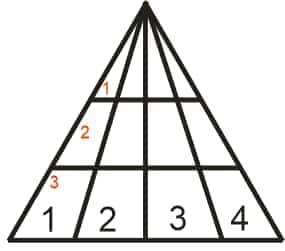
Here, the first step is the same as we did before, but after that step here we will multiply that by the number of horizontal parts.
As we can see, in the first figure, there are 2 horizontal parts, and in the second figure, there are 3 horizontal parts.
So, the number of triangles in the first figure $= 2 \times \left(\frac{2(2 + 1)}{2}\right) = 2 \times \left(\frac{6}{2}\right) = 2 \times 3 = 6$
So, the number of triangles in the second figure $= 3 \times \left(\frac{4(4 + 1)}{2}\right) = 3 \times \left(\frac{20}{2}\right) = 3 \times 10 = 30$
Now, let’s consider the triangles of another form.

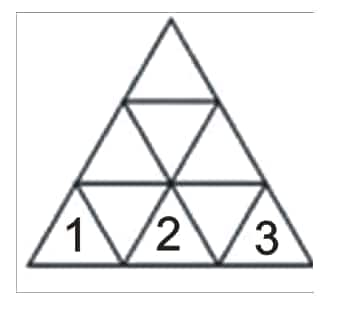
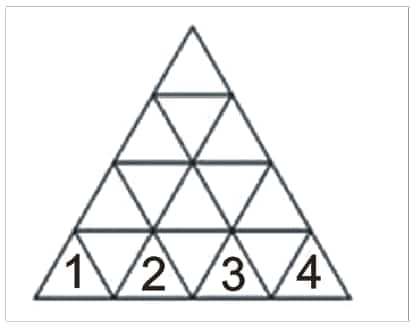
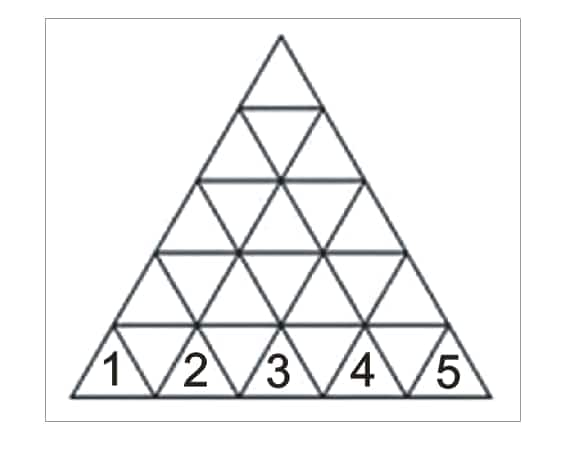
As, in the above figures, we can see a big triangle is divided into a number of small triangles. To count the number of triangles in the above figures, we have to determine the number of bases in the given figure and then apply the required formula. Let us consider that ‘n’ denotes the number of bases.
In the first figure, there are 2 bases, in the second figure, there are 3 figures, in the third figure, there are 4 bases, and in the fifth figure, there are 5 bases. So, the number of bases is even as well as odd. Based on the number of bases (either odd or even), there are 2 formulas.
So, the total number of triangles (when the number of bases is even) $= \frac{n(n + 2)(2n + 1)}{8}$
So, the total number of triangles (when the number of bases is odd) $= \frac{n(n + 2)(2n + 1) - 1}{8}$
For the first figure, $n = 2$ (Even)
So, the total number of triangles $= \frac{2(2 + 2)(2(2) + 1)}{8} = \frac{2 \times 4 \times 5}{8} = 5$
For the second figure, $n = 3$ (Odd)
So, the total number of triangles $= \frac{3(3 + 2)(2(3) + 1) - 1}{8} = \frac{(3 \times 5 \times 7) - 1}{8} = \frac{104}{8} = 13$
For the third figure, $n = 4$ (Even)
So, the total number of triangles $= \frac{4(4 + 2)(2(4) + 1)}{8} = \frac{4 \times 6 \times 9}{8} = 27$
For the fourth figure, $n = 5$ (Odd)
So, the total number of triangles $= \frac{5(5 + 2)(2(5) + 1) - 1}{8} = \frac{(5 \times 7 \times 11) - 1}{8} = \frac{384}{8} = 48$
3. Count the Number of Triangles in a Square or Rectangle
If we have to count the number of triangles in a square or a rectangle, then just simply multiply the total number of parts in the figure by 2 to get the required answer. The example is as follows:
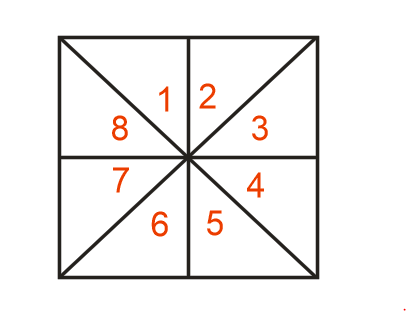
Here, in the above figure, there are a total of 8 parts of a square.
So, the total number of triangles = 2 × 8 = 16
For more practice, follow the figure counting questions below with answers of each type:
Practice Questions For Counting the Squares
Q1. Directions: How many squares are there in the given figure?

A) 10
B) 11
C) 12
D) 14 (Correct)
Solution: Label the given figure and then count the number of squares. The given figure can be labelled as shown below:
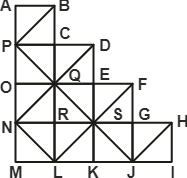
The squares in the above figure are - ABCP, PCQO, OQRN, NRLM, CDEQ, QESR, RSKL, EFGS, SGJK, GHIJ, PDSN, OEKM, QFJL and NLSQ. Thus, there are 14 squares in the above figure. Hence, the fourth option is correct.
Q2. Directions: How many squares are there in the given figure?
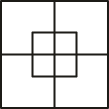
A) 8
B) 14
C) 10 (Correct)
D) 12
Solution: Label the given figure and then count the number of squares. The given figure can be labelled as shown below:
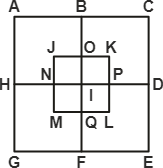
The squares in the above figure are - ABIH, HIFG, BCDI, IDEF, JKLM, JOIN, OKPI, IPLQ, NIQM, and ACEG. Thus, there are 10 squares in the above figure. Hence, the third option is correct.
Q3. Directions: How many squares are there in the given figure?
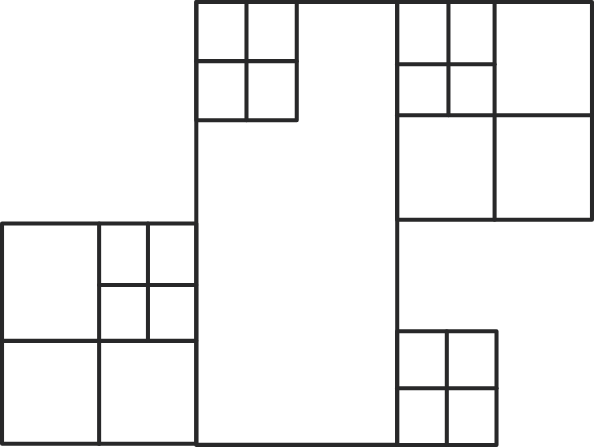
A) 28 (Correct)
B) 54
C) 53
D) 27
Solution: Label the given figure and then count the number of squares. The given figure can be labelled as shown below:

The squares in the above figure are - ABIH, HION, BCJI, OIJP, ACPN, DKLE, ELMF, KLRQ, LRSM, DQSF, FSTG, QSZY, ZSTa, YDGa, eUVf, fbcr, rcdg, VbcW, WcdX, fVXg, lefm, mfgn, hiks, iktj, oskp, pktq, ohjq, and lUXn. Thus, there are 28 squares in the above figure. Hence, the first option is correct.
Q4. Directions: How many squares are there in the given figure?
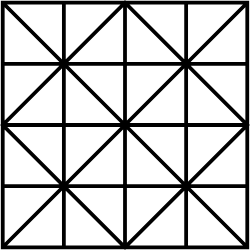
A) 26
B) 30
C) 35 (Correct)
D) 38
Solution: Label the given figure and then count the number of squares. The given figure can be labelled as shown below:

The squares in the above figure are - ABQP, BCXQ, CXRD, DRFE, POSQ, SQXT, TXRU, RUGF, OSVN, VSTY, YTUW, WUGH, NMLV, LKYV, KYWJ, JIHW, ACTO, BDUS, CTGE, NPXY, VQRW, YXFH, MOTK, LSUJ, KTGI, NADW, VBEH, MPRJ, LQFI, AEIM, KOCG, VOQT, TQCR, TRGW, and KVTW. Thus, there are 35 squares in the above figure. Hence, the third option is correct.
Q5. Directions: How many squares are there in the given figure?
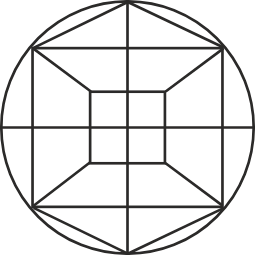
A) 11
B) 12
C) 10 (Correct)
D) 9
Solution: Label the given figure and then count the number of squares. The given figure can be labelled as shown below:
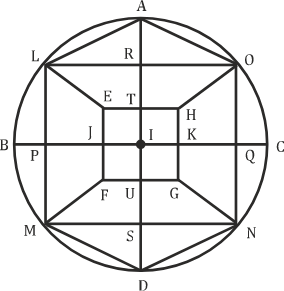
The squares in the above figure are - LMNO, EFGH, EJIT, TIKH, JFUI, IUGK, LPIR, RIQO, IPMS, and ISNQ. Thus, there are 10 squares in the above figure. Hence, the third option is correct.
Practice Questions For Counting the Rectangles
Q1. Directions: How many rectangles are there in the given figure?

A) 8
B) 5
C) 9 (Correct)
D) 4
Solution: Label the given figure and then count the number of rectangles. The given figure can be labelled as shown below:
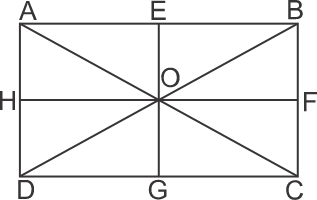
The rectangles in the above figure are - AEOH, EBFO, OFCG, HOGD, ABFH, HFCD, AEGD, EBCG, and ABCD. Thus, there are 9 rectangles in the above figure. Hence, the third option is correct.
Q2. Directions: How many rectangles are there in the figure ABCD?
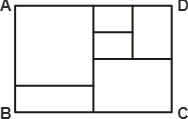
A) 11
B) 12
C) 9
D) 10 (Correct)
Solution: Label the given figure and then count the number of rectangles. The given figure can be labelled as shown below:
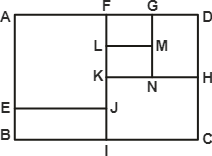
The rectangles in the above figure are - AEJF, EBIJ, KICH, NGDH, KLMN, FGML, FGNK, ABCD, AFIB, and FDCI. Thus, there are 10 rectangles in the above figure. Hence, the fourth option is correct.
Q3. Directions: How many rectangles are there in the given figure?
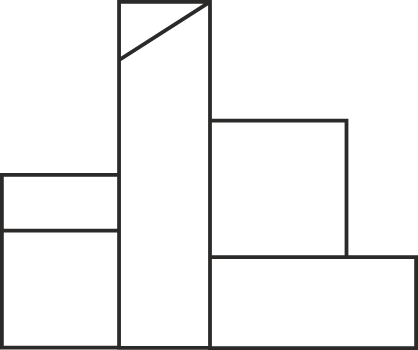
A) 8
B) 5
C) 6 (Correct)
D) 4
Solution: Label the given figure and then count the number of rectangles. The given figure can be labelled as shown below:

The rectangles in the above figure are - ABDC, CDFE, ABFE, ONGF, MLJK, and GKIH. Thus, there are 6 rectangles in the above figure. Hence, the third option is correct.
Q4. Directions: How many rectangles are there in the given figure?

A) 9 (Correct)
B) 7
C) 8
D) 10
Solution: Label the given figure and then count the number of rectangles. The given figure can be labelled as shown below:
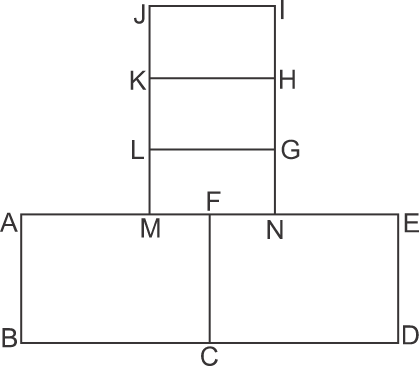
The rectangles in the above figure are - ABCF, CDEF, ABDE, MNGL, LGHK, KHIJ, MNHK, MNIJ, and LGIJ. Thus, there are 9 rectangles in the above figure. Hence, the first option is correct.
Q5. Directions: How many rectangles are there in the given figure?
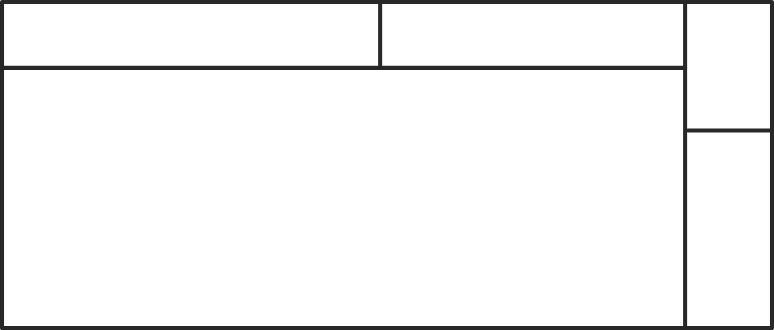
A) 6
B) 7
C) 8
D) 9 (Correct)
Solution: Label the given figure and then count the number of rectangles. The given figure can be labelled as shown below:

The rectangles in the above figure are - ABJI, BJLC, CDEK, EFGK, GHIL, ACGH, AHFD, AILC, and CDFG. Thus, there are 9 rectangles in the above figure. Hence, the fourth option is correct.
Practice Questions For Counting the Triangles
Q1. Directions: How many triangles are there in the given figure?

A) 24
B) 30
C) 28 (Correct)
D) 29
Solution: To solve the figure counting triangle reasoning questions, label the given figure and then count the number of triangles. The given figure can be labelled as shown below:

The triangles in the above figure are - AFG, AEG, AFE, BFJ, BDJ, BFD, CEI, CDI, CED, ABD, ACD, ABC, AHB, AHE, DEF, DEG, DFG, GHE, DEH, JHD, BEC, BHD, AEB, AFD, AED, DJE, FEJ, and BDE. Thus, there are 28 triangles in the above figure. Hence, the third option is correct.
Q2. Directions: How many triangles are there in the given figure?

A) 8
B) 10
C) 12 (Correct)
D) 14
Solution: To solve the figure counting triangle reasoning questions, label the given figure and then count the number of triangles. The given figure can be labelled as shown below:
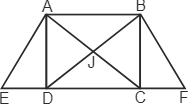
The triangles in the above figure are - ADE, BCF, AJD, DJC, CJB, BJA, ADC, DCB, CBA, BAD, EAC, and DBF. Thus, there are 12 triangles in the above figure. Hence, the third option is correct.
Q3. Directions: How many triangles are there in the given figure?
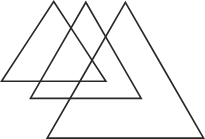
A) 4
B) 5
C) 7
D) 6 (Correct)
Solution: To solve the figure triangle counting questions, label the given figure and then count the number of triangles. The given figure can be labelled as shown below:
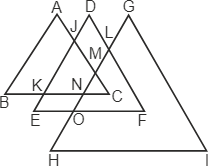
The triangles in the above figure are - ABC, DEF, GHI, JKC, MNC, and LOF. Thus, there are 6 triangles in the above figure. Hence, the fourth option is correct.
Q4. Directions: How many triangles are there in the given figure?
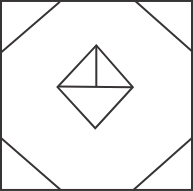
A) 9
B) 10
C) 11
D) 8 (Correct)
Solution: To solve the figure triangle counting questions, label the given figure and then count the number of triangles. The given figure can be labelled as shown below:

The triangles in the above figure are - AEF, GBH, ICJ, LDK, MNO, ONQ, MOQ, and MPQ. Thus, there are 8 triangles in the above figure. Hence, the fourth option is correct.
Q5. Directions: How many triangles are there in the given figure?
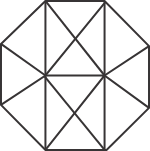
A) 20
B) 21
C) 22
D) 24 (Correct)
Solution: To solve the figure counting triangle reasoning questions, label the given figure and then count the number of triangles. The given figure can be labelled as shown below:
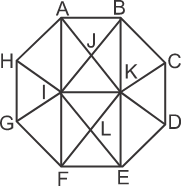
The triangles in the above figure are - ABJ, AIJ, IJK, BJK, ILF, FLE, LEK, ILK, BCK, CKD, KDE, AHI, HIG, GIF, AIK, BIK, IEF, KFE, IKF, IKE, ABK, AIB, AKF, and BIE. Thus, there are 24 triangles in the above figure. Hence, the fourth option is correct.
Practice Questions For Counting the Quadrilaterals
Q1. Directions: How many quadrilaterals are there in the given figure?

A) 17 (Correct)
B) 15
C) 14
D) 21
Solution: Label the given figure and then count the number of quadrilaterals. The given figure can be labelled as shown below:
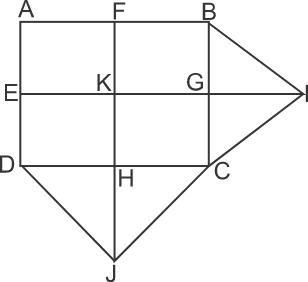
The quadrilaterals in the above figure are - AFKE, FBGK, EKHD, KGCH, ABGE, EGCD, AFHD, FBCH, ABCD, AFJD, FBCJ, EKJD, KGCJ, ABIE, FBIK, EICD, and KICH. Thus, there are 17 quadrilaterals in the above figure. Hence, the first option is correct.
Q2. Directions: How many quadrilaterals are there in the given figure?
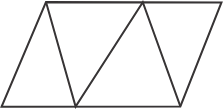
A) 7
B) 6 (Correct)
C) 4
D) 8
Solution: Label the given figure and then count the number of quadrilaterals. The given figure can be labelled as shown below:
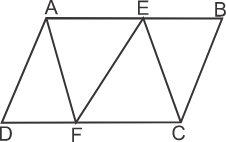
The quadrilaterals in the above figure are - ADFE, FEBC, ADCE, BCFA, AFCE, and ABCD. Thus, there are 6 quadrilaterals in the above figure. Hence, the second option is correct.
Q3. Directions: How many quadrilaterals are there in the given figure?

A) 16 (Correct)
B) 17
C) 15
D) 14
Solution: Label the given figure and then count the number of quadrilaterals. The given figure can be labelled as shown below:
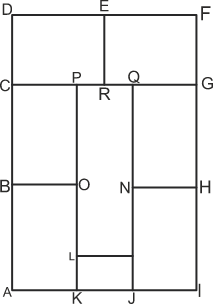
The quadrilaterals in the above figure are - ABOK, BCPO, CDER, ERGF, GHNQ, JNHI, JKLM, LPQM, KPQJ, IJQG, ACPK, CDFG, ADFI, ACGI, KPGI, and ACQJ. Thus, there are 16 quadrilaterals in the above figure. Hence, the first option is correct.
Q4. Directions: How many quadrilaterals are there in the given figure?
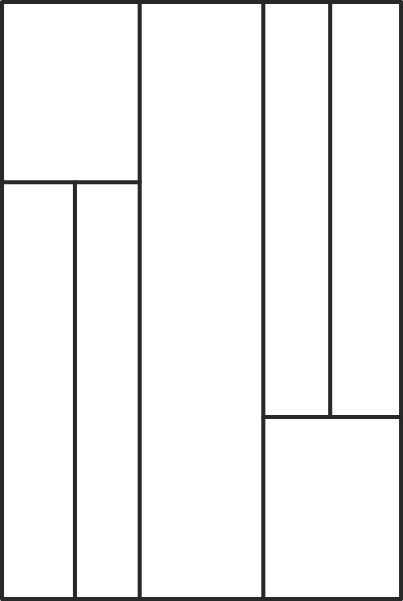
A) 15
B) 16
C) 14 (Correct)
D) 13
Solution: Label the given figure and then count the number of quadrilaterals. The given figure can be labelled as shown below:
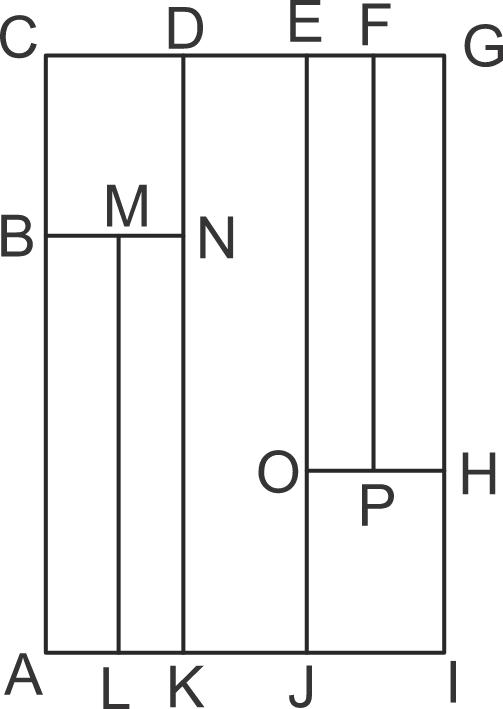
The quadrilaterals in the above figure are ABML, KLMN, ABNK, BCDN, ACDK, DEJK, EFPO, FGHP, EGHO, OHIJ, EGIJ, ACGI, ACEJ, and GIKD. Thus, there are 14 quadrilaterals in the above figure. Hence, the third option is correct.
Q5. Directions: How many quadrilaterals are there in the given figure?

A) 21
B) 22
C) 24 (Correct)
D) 23
Solution: Label the given figure and then count the number of quadrilaterals. The given figure can be labelled as shown below:

The quadrilaterals in the above figure are - AEFO, AEGP, AEHD, OFGP, OFHD, PGHD, ABMO, EBMF, OIJP, OMNP, FIJG, FMNG, IMNJ, PKLD, PNCD, GKLH, GNCH, KNCL, EBNG, EBCH, FMCH, ABNP, ABCD, and OMCD. Thus, there are 24 quadrilaterals in the above figure. Hence, the third option is correct.
Figure Counting Questions PDF Download
For more questions, you must practice from the figure counting questions PDF or download the e-book of figure counting questions with answers PDF given below:
Download Now: Figure Counting Questions with Solutions PDF
Figure Counting Questions for BITSAT/ CUET
In entrance exams such as BITSAT and CUET, generally 1 - 2 questions are asked, which the candidate can solve easily if they practice several questions based on the figure counting reasoning.
1) Directions: How many rectangles are there in the given figure?
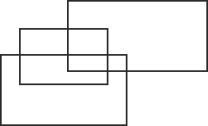
1) 9
2) 10
3) 11
4) 12
Solution
The given figure can be labelled as shown below –
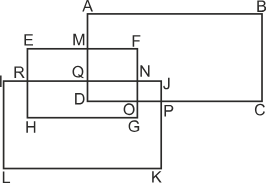
There are a total of 11 rectangles in the above figure. They are ABCD, EFGH, IJKL, MFNQ, EMQR, EFNR, QNOD, NJPO, QJPD, RNGH, MFOD.
Hence, the third option is correct.
Figure Counting Questions for SSC CGL/ SSC CHSL/ SSC CPO/ SSC Stenographer exams
1) Directions: How many triangles are there in the given figure?
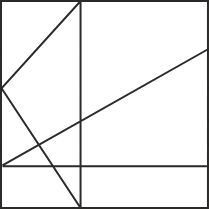
1) 11
2) 9
3) 10
4) 12
Solution
The given figure can be labelled as shown below –
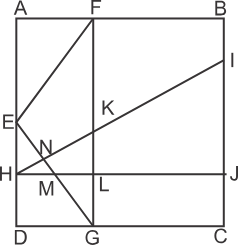
There are a total of 10 triangles in the above figure. They are AFE, EDG, EFG, EHN, HNM, EHM, HIJ, GML, GNK, HKL.
Hence, the third option is correct.
2) Directions: How many triangles are there in the given figure?

1) 28
2) 36
3) 40
4) 48
Solution
The figure can be labelled as shown below –
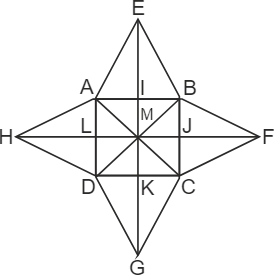
There are a total of 36 triangles in the above figure. They are AEI, IEB, BJF, CJF, DKG, CKG, HAL, DHL, AEB, BFC, CGD, DHA, AML, LMD, DMK, KMC, CMJ, JMB, BMI, IMA, AMD, DMC, CMB, BMA, ADC, DCB, CBA, BAD, HAM, HDM, MBF, MCF, MDG, MCG, MAE, MBE.
Hence, the second option is correct.
Figure Counting Questions for Railway Recruitment Board - RRB Exams
1) Directions: How many triangles are there in the given figure?
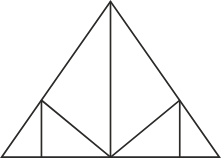
1) 10
2) 11
3) 12
4) 13
Solution
The figure can be labelled as shown below –
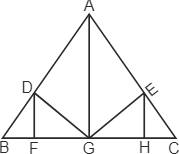
There are 11 triangles in the above figure. They are ABC, AGB, AGC, DBF, DFG, DBG, GEH, HEC, GEC, ADG, AEG.
Hence, the second option is correct.
Previous Year Questions of Figure Counting in Various Exams
1) Directions: How many triangles are there in the given figure?

1) 22
2) 21
3) 16
4) 24
Hint: To solve the reasoning triangle questions, firstly, label the given figure and determine the total number of triangles contained within it.
Solution
The given figure can be labelled as shown below –
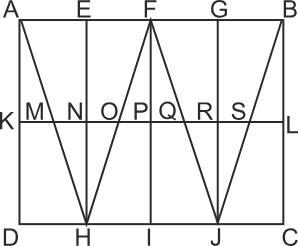
In the above-labelled figure, there are a total of 22 triangles. They are AKM, ADH, HNM, HEA, HNO, HEF, HMO, HAF, FOP, FHI, FPQ, FIJ, FOQ, FHJ, JRQ, JGF, JRS, JGB, JQS, JFB, BSL, BJC.
Hence, the first option is correct.
2) Directions: How many triangles are there in the given figure?

1) 10
2) 13
3) 12
4) 11
Hint: To solve the reasoning triangle questions, firstly, label the given figure and determine the total number of triangles contained within it.
Solution
The given figure can be labelled as shown below –
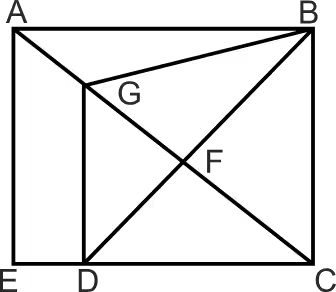
Now, in the above figure, there are a total of 12 triangles. They are GFD, GBF, GDB, DFC, BFC, DBC, AEC, BAC, BGC, DGC, BAG, and BAF.
Hence, the third option is correct.
3) Directions: Find the total number of triangles in the figure.
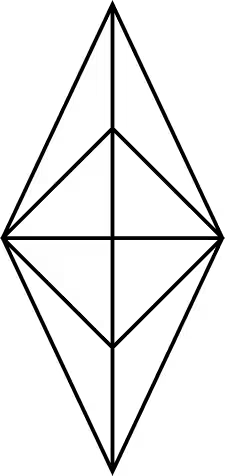
1) 18
2) 24
3) 16
4) 26
Hint: Label the given figure and determine the total number of triangles contained within it.
Solution
The given figure can be labelled as shown below –
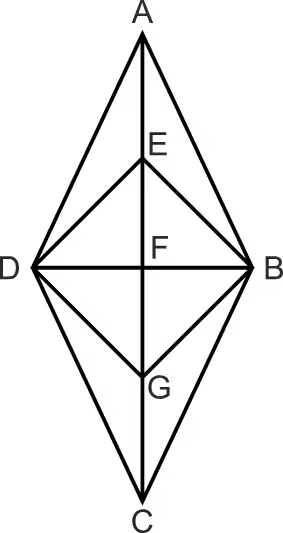
In the above-labelled figure, there are a total of 24 triangles. They are AED, AEB, CGD, CGB, AFD, AFB, CFD, CFB, ABC, ADC, ADG, ABG, CDE, CBE, DEF, EFB, BFG, GFD, DEB, EBG, BGD, DGE, ABD, CBD.
Hence, the second option is correct.
4) Directions: How many triangles are there in the given figure?
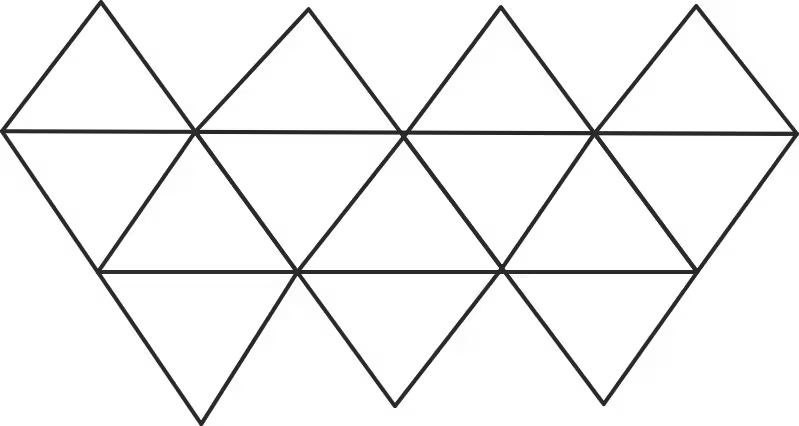
1) 18
2) 14
3) 19
4) 16
Hint: To solve the reasoning triangle questions, firstly, label the given figure and determine the total number of triangles contained within it.
Solution
The given figure can be labelled as shown below –
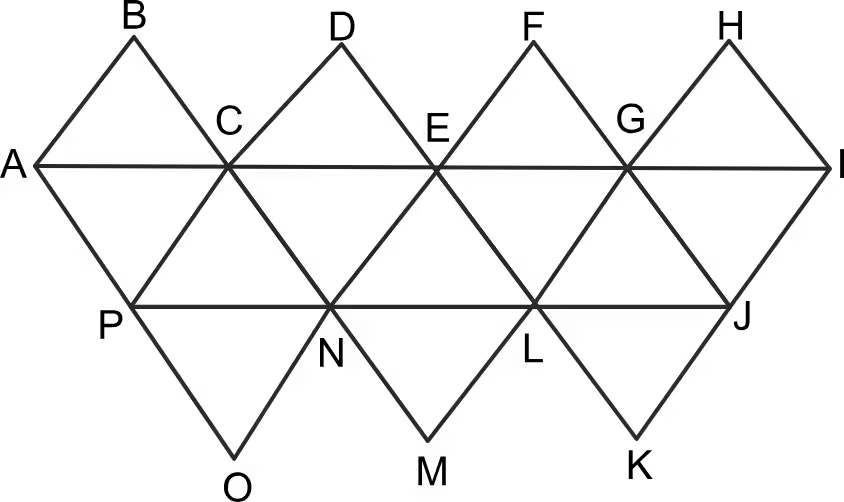
Now, in the above figure, there are a total of 19 triangles. They are ABC, CDE, EFG, GHI, ACP, PCN, CEN, NEL, GEL, GLJ, GIJ, PON, NML, LKJ, PDL, NFJ, AEO, EKI, CGM.
Hence, the third option is correct.
5) Directions: How many triangles are there in the given figure?

1) 20
2) 10
3) 18
4) 8
Hint: Label the given figure and then count the number of triangles in the labelled figure.
Solution
The given figure can be labelled as shown below –
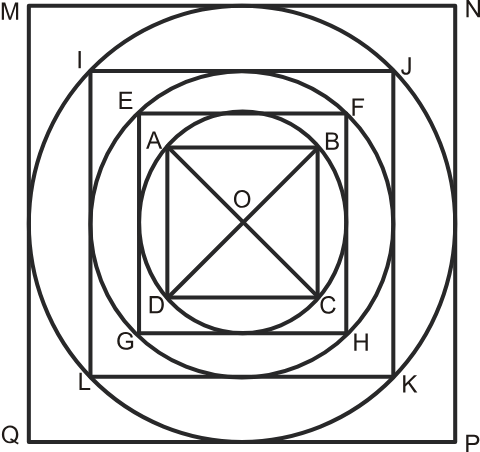
Now, in the above figure, there are a total of 8 triangles. They are AOB, BOC, COD, AOD, ABC, BCD, ACD, ADB.
Hence, the fourth option is correct.
6) Directions: How many triangles are there in the given figure?
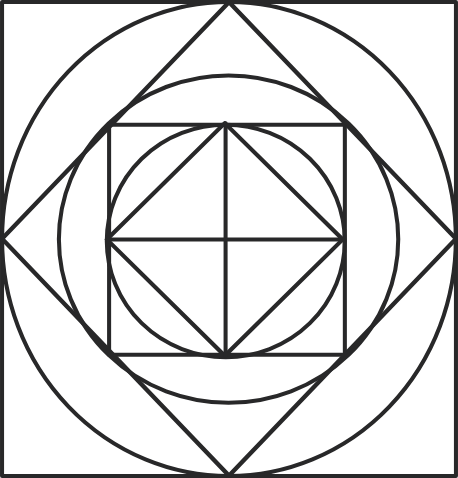
1) 20
2) 22
3) 24
4) 18
Hint: To solve the reasoning triangle questions, firstly, label the given figure and determine the total number of triangles contained within it.
Solution
The given figure can be labelled as shown below –
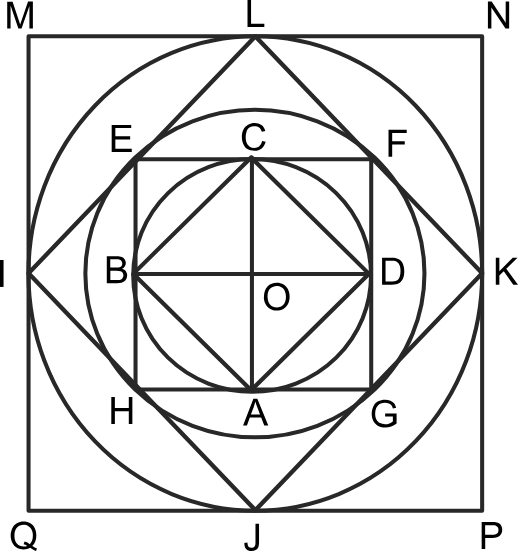
Now, in the above figure, there are a total of 20 triangles. They are AOB, AOD, COD, BOC, ACD, ABC, BCD, ABD, BEC, CFD, AGD, AHB, IEH, JGH, KFG, LEF, MIL, NKL, PKJ, OIJ.
Hence, the first option is correct.
7) Directions: How many triangles are there in the given figure?
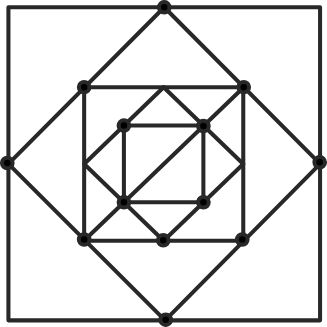
1) 26
2) 24
3) 22
4) 28
Hint: Label the given figure and then count the number of triangles in the labelled figure.
Solution
The given figure can be labelled as shown below –
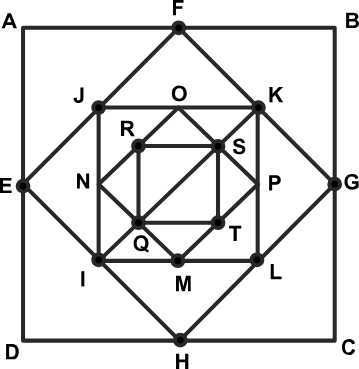
Now, in the above figure, there are a total of 24 triangles. They are AEF, FBG, GHC, DEH, EJI, FJK, GKL, LHI, MIN, MIQ, NIQ, JNO, POK, OSK, PKS, MPL, NQR, ORS, PTS, TQM, QRS, QST, IJK, IKL.
Hence, the second option is correct.
Preparation Tips for Figure Counting
Effective preparation for figure counting reasoning questions involves enhancing your observation and analytical skills, learning counting figures tricks, and practicing regularly. These strategies help aspirants master counting of figures questions with answers efficiently, improving both accuracy and speed for competitive exams like CAT, SSC, RRB, IBPS, and banking tests.
How to Improve Speed in Counting Figures
Break complex diagrams into smaller parts, count shapes systematically, and apply short methods for triangle and polygon counting to solve figure counting reasoning questions faster.
Daily Practice Strategy for Figure Counting Reasoning
Solve a fixed set of counting figures questions daily, combining simple and tricky diagrams to strengthen recognition skills and accuracy in reasoning ability tests.
Using Counting Figure Tricks for Accuracy
Use proven figure counting tricks, such as symmetry detection, repeated pattern recognition, and layer-by-layer counting, to ensure no hidden shapes are missed in complex diagrams.
Common Mistakes to Avoid in Counting Figures
Avoid double-counting shapes or overlooking overlapping and nested figures, common pitfalls in figure counting reasoning problems.
Balancing Speed and Accuracy in Exams
Set a time limit for each figure counting question while double-checking your totals to maintain a balance between speed and accuracy in competitive exams.
Verbal Reasoning Topics
Verbal reasoning topics evaluate your ability to understand, analyze, and logically interpret information presented in words or numbers. Key areas include distance and direction reasoning, arithmetic problems, seating arrangement, blood relation, missing number, series, inequality, order and ranking, verification of statements, coding-decoding, Venn diagrams, and syllogism, all essential for competitive exam success. The verbal reasoning topics are given below.
Arithmetic Problems Reasoning | |
About the Faculty
Tanu Gupta, with over a decade of experience as a reasoning faculty, specializes in preparing students for various entrance examinations and career development. Her extensive work with multiple educational platforms and institutions has honed her expertise in logical and analytical thinking. Her dedication to innovative teaching methods ensures these articles provide practical insights and expert guidance.
Frequently Asked Questions (FAQs)
The level of the questions of the figure counting has been seen as easy to moderate in the examinations.
The questions related to figure counting are asked in various competitive exams such as SSC, Bank PO, Bank Clerk, Railway, Defence, UPSC, State PCS, etc.
In the SSC exams around 2-3 questions have been asked every year whereas in other exams like Railways, CUET or Defence mostly 1-2 questions have been asked.
The counting of figures is defined as to identify the number of a figures in a given known shape. In this you have to identify that how many figures are there in the given shape.
Label the given adjoining figure, and point out the different vertices that together make the complete figure. By using these vertices, you can count the number of shapes in the given figure.
A figure is defined as a geometric shape that is a combination of lines, planes, or points that form a closed boundary. So, when you join two points or lines to create a geometric shape, you can consider it as a figure.